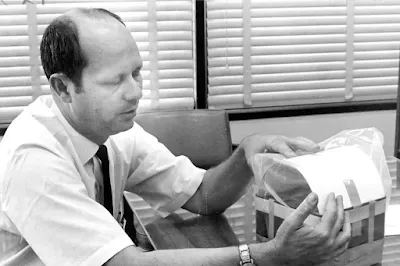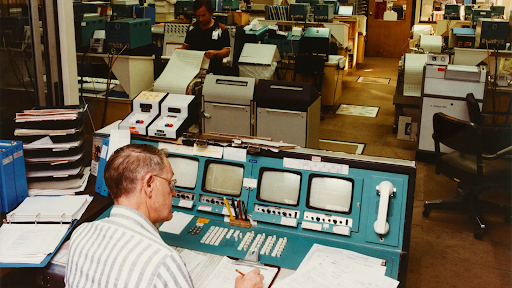Serving the worldwide community of radio-electronic homebrewers. Providing blog support to the SolderSmoke podcast: http://soldersmoke.com
Podcasting since 2005! Listen to Latest SolderSmoke
Monday, May 19, 2025
Wednesday, May 14, 2025
The Computer Hardware of the Apollo Program
Sunday, March 16, 2025
CuriousMarc Gets an Apollo DSKY Running. FPGA AGC Computer. Rope Memory.
Thursday, January 30, 2025
Video of images and Data Stream: Huygens Probe Parachuting onto Titan
Wednesday, September 18, 2024
Vulnerable MOSFETS in NASA's Europa Clipper
Thursday, September 5, 2024
Who can tell us more about Lovelock's homebrew shortwave radio?
Sunday, September 1, 2024
CuriousMarc Visits Cape Canaveral -- Lots of Space History (and some ham gear)
Friday, August 23, 2024
Arthur C. Clarke Talks about Satellites, SETI, Remote Work, and Wrist Radios (1976 Video)
Monday, May 27, 2024
Ham Radio in China -- Interesting info from 高大伟 David Cowhig
David Cowhig (aka WA1LBP, aka Gao Da Wei) was Hambassdor for 73 Magazine on Okinawa when I held a similar "position" on the island of Hispaniola. David is a real Asia hand, and is fluent in both Mandarin and Japanese. He is uiniquely sitated to provide info on ham radio in China. In a recent post he provides this info, and describes how we may soon be hearing from ham Taikonauts in space:
https://gaodawei.wordpress.com/2024/05/22/2024-ham-radio-in-china-soon-chinese-hams-in-space/
Thanks David!
Wednesday, May 15, 2024
CuriousMarc Looks at Phase-Locked Loops (PLL)
Friday, April 19, 2024
Deep Space Station 43 -- Canberra, Australia
DSS-43 boasts a pointing accuracy of 0.005 degrees (18 arc seconds)—which is important for ensuring that it is pointed directly at the receiver on a distant spacecraft. Voyager 2 broadcasts using a 23-watt radio. But by the time the signals traverse the multibillion-kilometer distance from the heliopause to Earth, their power has faded to a level 20 billion times weaker than what is needed to run a digital watch. Capturing every bit of the incident signals is crucial to gathering useful information from the transmissions.
The antenna has a transmitter capable of 400 kilowatts, with a beam width of 0.0038 degrees. Without the 1987 upgrade, signals sent from DSS-43 to a spacecraft venturing outside the solar system likely never would reach their target.
Thursday, December 21, 2023
Sci-Fi Series with an Apollo-era Vibe
Here is a review:
Thursday, November 30, 2023
Other Workshops: Mission to Jupiter's Icy Moons: The Making of JUICE: The Full Movie
I wonder how the procedures we see in this film compare to the famed spacecraft-building procedures of the Jet Propulsion Laboratory in California. But just remember: When it came time to launch the Webb Space Telescope, NASA opted to launch from the ESA facility in French Guiana. Their Ariane rocket apparently had a better success rate than ours. But it did seem to me that they did discover problems with some of the instruments in the thermal phase of the "shake and bake" but then corrected them without re-running the thermal tests. Was that a violation of test principles?
Watching this movie makes me really want to take out my small telescope and aim it at Jupiter (which is now high in our evening sky).
We see a lot of "soul" built into this new machine: the inclusion in the spacecraft of a copy of pages from Galileo's Starry Messenger and the names of those involved in the project, and the selection of the faring logo from a children's contest, for example. Yaryna, the young Ukrainian artist who drew the logo at age 8, even mentions "soul" in her remarks.
Godspeed, JUICE!
Monday, November 27, 2023
Video on Discovery and Restoration of the Apollo Guidance Computer
Sunday, October 29, 2023
Apollo Core Rope Memory -- CuriousMarc Takes it on (video)
Wednesday, October 11, 2023
Sunburst and Luminary: Apollo "Rope" Memory, and other items of interest
Wow. That is the method that they stored computer memory for the moon missions. When they were satisfied with a program they would say it was time to "put it on the rope."
Here's an article on the women who built the rope memory (and the integrated circuits used in Apollo). This reminded me of the women's collective in Hyderabad that "wove" the ferrite core transformers for Farhan's BITX rigs:
Here is a Wikipedia article on core rope ROM memory with some great illustrations:
https://en.wikipedia.org/wiki/Core_rope_memory
-- Not long before the fatal Apollo 1 fire, an MIT colleague of Don Eyles had a drink with Astronaut Gus Grissom. Grissom unloaded about the poor state of the spacecraft, saying that, "What we have here is a Heathkit." Grissom died in the fire.
-- Eyles mentions the use of 6L6 tubes in analog audio amplifiers.
-- MIT's Doc Draper used a Minox camera.
-- When the Apollo 11 astronauts came back and were living for two weeks in an isolation chamber, NASA had bulldozers on standby to bury the whole thing ("astronauts, staff and all") in case some dangerous moon bug was detected. (Is that true?)
-- At one point soon before an important missile test, engineers realized that they needed an isolation transformer. They did not have enough time to order one. So they took an isolation transformer out of one of their soldering stations and used it in the missile. It worked. Sometimes you just use what you have on hand.
Wednesday, October 4, 2023
Sunburst and Luminary -- A Poem about Transistors and ICs
Monday, October 2, 2023
"Sunburst and Luminary" author Don Eyles was a Ham, a Hacker, and a user of Plywood who Understood Juju
-- As a kid, Eyles took a summertime shop class with W4LRO. Eyles himself went on to get his ham license -- he was K4ZHF and was active for a while on the 40 meter and 6 meter bands.
-- He writes of how the Apollo software acquired more "juju as labor and logic were poured into them." Juju.
-- He describes the electronics lab in the MIT Instrumentation Laboratory: "If you had a private project you could sometimes get some simple milling done for a smile, and you could scrounge the odd resistor or capacitor... On the second floor there was a small "hackers shop" with a drill press, metal shear, a bending brake, and a few hand tools which was open to anyone, including software engineers. That was the first use of the term "hack" in a technical context, that I can recall hearing. I took the term as referring to the sometimes messy process by which perforations of suitable sizes were made in the aluminum boxes, or chassis, that were used for constructing electronic devices." Indeed. We hack.
-- After describing the first integrated circuits, Eyles looks back at high school and notes that he and a friend, "after learning about truth tables, James Chambers and I had experimented with similar devices composed of relays mounted on a piece of plywood." Plywood.
More to follow on this book.












